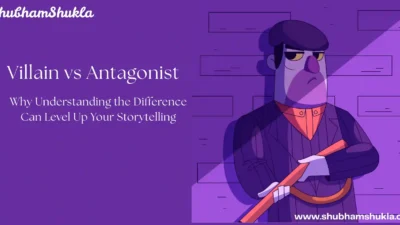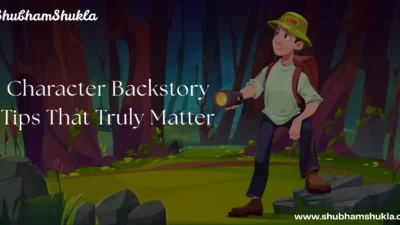Let’s face it — not every character in your story is going to be the hero. But that doesn’t mean they’re forgettable. Some of the most memorable figures in fiction show up for just a scene or two, yet leave a lasting impression. These are what we call scene characters — and they’re more important than they often get credit for.
Today, we’re diving into what scene characters are, why they matter, and how to make yours stand out in ways that support your story and delight your readers.
- What Are Scene Characters, Exactly?
- Why Scene Characters Should Never Be Flat
- Making Scene Characters Memorable
- In My Own Experience, I Found That…
- Great Examples of Scene Characters in Fiction
- Showing, Not Telling: How to Reveal Scene Characters
- Encouragement Before You Go
- FAQ: Scene Characters in Writing
What Are Scene Characters, Exactly?
Scene characters are those individuals who may not play a major role in the entire plot but appear in specific scenes to serve a purpose sometimes to move the story forward, sometimes to challenge or support your main character, and sometimes just to add depth to your fictional world.
Think about Stanley Yelnats’ bus driver in Holes the one who drops him off at Camp Green Lake and doesn’t say a word. That silence sets the tone. Or Madam Pomfrey in Harry Potter not a central figure, but always present when healing is needed.
These scene characters might not dominate page time, but they serve the story in big ways.
Why Scene Characters Should Never Be Flat
Too often, writers treat scene characters as cardboard cutouts: “the waiter,” “the guard,” “the old man on the bench.” But your readers notice when someone feels like a placeholder. A vivid, well-drawn scene character can bring richness and realism to your work.
Let’s not forget Effie Trinket from The Hunger Games. Her outlandish personality, her blind optimism — she’s the Capitol personified in heels and glitter. And while she’s not the protagonist, her presence transforms several key scenes.
If you want your readers to feel immersed in your world, your scene characters need to feel like real people — even if we only meet them once.
You may also like: Top 10 Names of Demons in the Bible
Making Scene Characters Memorable
Creating standout scene characters doesn’t mean writing full backstories or naming every store clerk. Instead, focus on three simple things:
1. Give Them a Goal
Even if they’re only on the page for a paragraph, they should want something. The goal could be as small as rushing a customer, helping a stranger, or covering up their nervousness. Giving scene characters a motive adds instant depth.
2. Use Distinct Dialogue or Behavior
Try giving them a speech pattern, a physical tic, or an unexpected attitude. A nervous bartender who rambles about his cat? Memorable. A janitor who gives wise advice? Classic and impactful.
3. Let Them Affect the Scene
They don’t need to steal the spotlight, but a good scene character should change something. Maybe they give the protagonist a clue, push their buttons, or even slow down the pace for a beat of humanity.
In My Own Experience, I Found That…
…scene characters often surprised me the most during my writing process. I once had a side character a nosy neighbor who was supposed to appear just once end up becoming a key comic relief throughout the book.
Readers loved her. What I thought would be a throwaway moment turned into a fan favorite.It reminded me how important it is not to underestimate the power of those quick interactions.
Even when they’re brief, scene characters bring color and spontaneity. They make your world feel lived in. My advice? When writing them, approach the page with curiosity. What are they doing when they’re not in the spotlight? What’s their story?
You may also like: Top 10 JK Rowling Books Ranked by Readers
Great Examples of Scene Characters in Fiction
Let’s talk about a few books that nail their scene characters:
- The Night Circus by Erin Morgenstern: Every performer, assistant, and vendor feels drenched in magic, even when they appear for just a page. The author treats each scene as a stage, and every character — however fleeting — gets a spotlight.
- Sherlock Holmes stories by Arthur Conan Doyle: Whether it’s the landlady Mrs. Hudson or a forgettable witness, everyone serves a purpose and feels distinct.
- The Book Thief by Markus Zusak: Death as a narrator is certainly not a traditional scene character, but the people who weave in and out of Liesel’s life — neighbors, soldiers, shopkeepers — all leave their mark.
In these stories, scene characters aren’t just there to fill space. They shape mood, tone, and even character development.
Showing, Not Telling: How to Reveal Scene Characters
Here’s the thing — you don’t always need full descriptions. Sometimes just how a character behaves or what they notice tells the reader all they need to know.
Imagine a teenage protagonist sits in a café after a heartbreak. The barista doesn’t speak much, but they bring a free cookie, saying, “Looks like a two-cookie kind of day.” Boom — instant connection. That’s a scene character we remember.
Keep it subtle. Trust your reader. Let a small gesture do the heavy lifting.
Encouragement Before You Go
Scene characters might not get their names on the cover, but they help build the world your readers fall in love with. They show us the texture of your story, the feel of the community, the contrast to your hero’s journey.
Don’t be afraid to have fun with them. Let them surprise you. Sometimes those quiet, quirky figures are what stick with readers the most.
FAQ: Scene Characters in Writing
Q1: What’s the main difference between scene characters and side characters?
Scene characters appear in one or a few scenes with a specific purpose. Side characters usually appear more often and support subplots or relationships.
Q2: Should scene characters have names?
Only if it adds clarity or emotional weight. “The shopkeeper” might be enough. But if they have a strong personality or significance, naming them can help.
Q3: Can a scene character become more important later?
Absolutely! Many beloved characters started as scene characters. Let your story evolve.
Q4: How many scene characters are too many?
As long as each serves a purpose and doesn’t confuse your reader, there’s no hard limit. Prioritize clarity and impact.
Whether they speak one line or shape an entire scene, scene characters deserve your creative attention. They’re the unsung heroes of fiction — and with just a little effort, they can help turn good stories into unforgettable ones.



